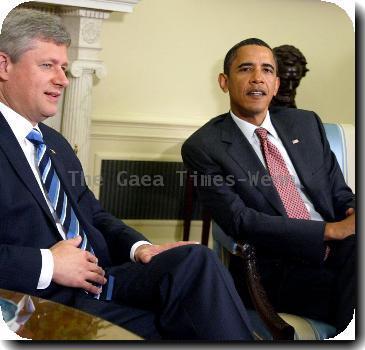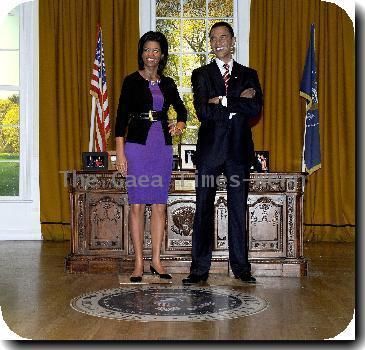Thousands of US, Afghan forces storm Taliban stronghold; biggest offensive since 2001
By Christopher Torchia, APSaturday, February 13, 2010
Major attack on Taliban stronghold launched
MARJAH, Afghanistan — Thousands of U.S. Marines and Afghan soldiers stormed the Taliban stronghold of Marjah on Saturday, pushing into the biggest town under militant control in a major offensive to break the extremists’ grip over a wide area of their southern heartland.
Punching their way through a line of insurgent defenses that included mines and homemade bombs, ground forces crossed a major canal into the town’s northern entrance.
Maj. Gen. Nick Carter, NATO commander of forces in southern Afghanistan, said Afghan and coalition troops, aided by 60 helicopters, made a “successful insertion” into Marjah without incurring any casualties.
“The operation went without a single hitch,” Carter said at a briefing in the provincial capital of Lashkar Gah.
Carter said the strike force quickly gained ground as it moved into Marjah and overran disorganized insurgents. “We’ve caught the insurgents on the hoof, and they’re completely dislocated,” he said.
At least 20 insurgents have been killed and 11 arrested so far in the offensive, said Gen. Sher Mohammad Zazai, the commander of Afghan forces in the region. Troops have recovered Kalashnikov rifles, heavy machine guns and grenades from those captured, he said.
Zazai characterized the Taliban resistance as light, saying he had no reports yet of Afghan or NATO casualties.
President Hamid Karzai called on Afghan and international troops “to exercise absolute caution to avoid harming civilians,” including avoiding airstrikes in areas where civilians are at risk. In a statement, he also called on insurgent fighters to use the opportunity to renounce violence and reintegrate into civilian life.
The long-awaited assault on Marjah in Helmand province is the biggest offensive since the 2001 U.S.-led invasion of Afghanistan and is a major test of a new NATO strategy focused on protecting civilians. The attack is also the first major combat operation since President Barack Obama ordered 30,000 U.S. reinforcements here in December to try to turn the tide of the war.
The troops’ advance into Marjah was slowed during the morning as they carefully picked their way through poppy fields lined with homemade explosives and other land mines.
Gunfire was ringing through the town by midday Saturday. The bridge over the canal into Marjah from the north was so rigged with explosives that Marines erected temporary bridges to cross into the town.
Lance Corp. Ivan Meza, 19, was the first to walk across one of the flimsy bridges.
“I did get an adrenaline rush, and that bridge is wobbly,” said Meza, a Marine combat engineer from Pismo Beach, California, who is with the 1st Platoon, Lima Company, 3rd Battalion, 6th Marines.
Several civilians hesitantly crept out of compounds as the Marines slowly worked through a suspected mine field. The Marines entered compounds first to make sure they were clear of bombs, then called in their Afghan counterparts to interview civilians inside.
Shopkeeper Abdul Kader, 44, said seven or eight Taliban fighters who had been holding the position where the Marines crossed over had fled in the middle of the night. He said he was angry at the insurgents for having planted bombs and mines all around his neighborhood.
“They left with their motorcycles and their guns. They went deeper into town,” he said as Marines and Afghan troops searched a poppy field next to his house. “We can’t even walk out of our own houses.”
The ground assault followed many hours after an initial wave of helicopters carrying hundreds of U.S. Marines and Afghan troops swooped into town under the cover of darkness early Saturday. Cobra helicopters fired Hellfire missiles at tunnels, bunkers and other defensive positions.
Marine commanders had said they expected between 400 to 1,000 insurgents — including more than 100 foreign fighters — to be holed up in Marjah. The town of 80,000 people, about 360 miles (610 kilometers) southwest of Kabul, is the biggest southern town under Taliban control and the linchpin of the militants’ logistical and opium-smuggling network.
The operation, code-named “Moshtarak,” or “Together,” was described as the biggest joint operation of the Afghan war, with 15,000 troops involved, including some 7,500 troops fighting in Marjah.
To the north, British, American and Canadian forces struck in the Nad Ali district in a push to break Taliban power in Helmand, one of the major battlefields of the war.
Once Marjah is secured, NATO hopes to rush in aid and restore public services in a bid to win support among the estimated 125,000 people who live in the town and surrounding villages. The Afghans’ ability to restore those services is crucial to the success of the operation and to prevent the Taliban from returning.
Carter said coalition forces hope to install an Afghan government presence within the next few days and will work to find and neutralize improvised explosive devices — homemade bombs — left by the militants.
Tribal elders have pleaded for NATO to finish the operation quickly and spare civilians — an appeal that offers some hope the townspeople will cooperate with Afghan and international forces once the Taliban are gone.
Still, the town’s residents have displayed few signs of rushing to welcome the attack force.
“The elders are telling people to stay behind the front doors and keep them bolted,” Carter said. “Once people feel more secure and they realize there is government present on the ground, they will come out and tell us where the IEDs are.”
The overwhelming military edge already seen in the first hours of the offensive will be essential to maintain, Carter said. “Everybody needs to understand that it’s not so much the clear phase that’s decisive. It’s the hold phase.”
Carter said the coalition offensive was “personally endorsed and sanctioned” by Karzai during consultations the day before troops went on the move.
A defense official at the Pentagon said Karzai was informed of planning for the operation well in advance. The official said it marked a first in terms of both sharing information prior to the attack and planning collaboration with the Afghan government.
The Marjah offensive involves close combat in extremely difficult terrain, that official said. A close grid of wide canals dug by the United States as an aid project decades ago make the territory a particularly rich agricultural prize, but they complicate the advance of U.S. forces.
On the eve of the attack, cars and trucks jammed the main road out of Marjah as hundreds of civilians defied militant orders and fled the area. For weeks, U.S. commanders had signaled their intention to attack Marjah in hopes that civilians would seek shelter.
Associated Press writers Noor Khan in Kandahar, Christopher Torchia outside Marjah, Amir Shah in Kabul, and Anne Gearan, Stephen Braun and Anne Flaherty in Washington contributed to this report.
Tags: Afghanistan, As-afghanistan, Asia, Barack Obama, Central Asia, Geography, Improvised Explosives, Kabul, Marjah, North America, United States

